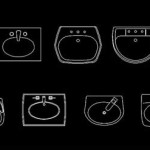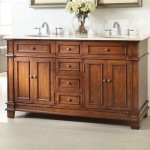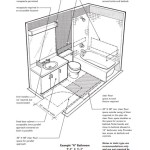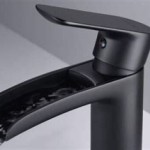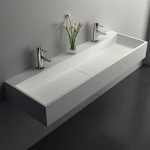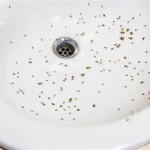Little White Worms in Bathroom Sink: Identification, Causes, and Remediation
The observation of small, white worms in the bathroom sink can be a distressing and unsettling discovery. These creatures are not only aesthetically unpleasant but also raise concerns about hygiene, sanitation, and potential health risks. This article aims to provide a comprehensive overview of the possible causes of these worms, methods for their identification, and strategies for effective remediation and prevention. Understanding the underlying issues is crucial for eliminating the infestation and maintaining a healthy bathroom environment.
Numerous factors can contribute to the presence of white worms in bathroom sinks. These factors often relate to environmental conditions that favor the worms' life cycle, such as moisture, organic matter, and suitable temperatures. Identifying the specific type of worm is essential for implementing the most appropriate treatment plan. Misidentification can lead to ineffective solutions and a persistent problem.
Identifying the Culprit: Common Types of White Worms
Several types of small, white worms could potentially infest a bathroom sink area. Accurate identification is the first step in determining the appropriate course of action. The most common culprits include drain fly larvae, moth fly larvae, and nematodes.
Drain Fly Larvae (Psychodidae): These larvae are frequently found in drains and sewage systems. Drain flies, also known as moth flies due to their fuzzy appearance, lay their eggs in stagnant water rich in organic material. The larvae are typically small, dark-headed, and segmented, with a grayish-white or brown body. They feed on accumulated organic matter lining the drain pipes, contributing to the problem's perpetuation. Adult drain flies are nuisance pests, and their presence indicates a breeding ground within the plumbing system.
Moth Fly Larvae (Psychodidae): As noted above, these are effectively the same as drain fly larvae. The terms are often used interchangeably. Their presence is strongly correlated with unsanitary conditions in drains and pipes. Controlling their breeding requires thorough cleaning and disinfection of affected areas.
Nematodes (Roundworms): Nematodes are a diverse group of roundworms, and some species can appear as small, white, thread-like worms. While many nematodes are beneficial soil organisms, certain species can be parasitic or thrive in decomposing organic matter. Their presence in a bathroom sink is less common than drain fly larvae but may occur in areas with persistent moisture and organic buildup. Differentiating nematodes from fly larvae requires closer examination of their morphology and behavior.
Enchytraeids (Pot Worms): These are less common but possible. They are small, white worms that thrive in damp environments with decaying organic matter. While typically found in soil or compost, they can occasionally infest damp areas in bathrooms where organic debris accumulates. They are not parasitic and primarily feed on decomposing materials.
Visual inspection, ideally with magnification, is crucial for distinguishing between these different types of worms. Examining their shape, size, color variations, and movement patterns can provide valuable clues. Taking a photograph and comparing it with online resources or consulting with a pest control professional can aid in accurate identification.
Causes and Contributing Factors
Understanding the factors that contribute to the presence of these worms is essential for effective prevention and control. Addressing these underlying causes is as important as eliminating the existing infestation.
Organic Matter Accumulation: The primary attractant for many of these worms is the presence of organic matter. Food particles, hair, soap scum, and other bathroom debris can accumulate in drain pipes, providing a rich food source for larvae and nematodes. Over time, this buildup creates an ideal breeding ground for these organisms. Regular cleaning and maintenance of drains are crucial for preventing organic matter accumulation.
Moisture and Humidity: Moisture is another essential factor that supports the survival and reproduction of these worms. Bathrooms are naturally humid environments, and leaky faucets or pipes can create persistent dampness that favors their proliferation. Addressing plumbing issues and ensuring proper ventilation can help reduce moisture levels and make the environment less hospitable to these pests.
Poor Ventilation: Inadequate ventilation can exacerbate moisture problems and create conditions that promote the growth of mold and mildew. These fungi can serve as an additional food source for some types of worms. Improving ventilation through the use of exhaust fans or opening windows can help reduce humidity and inhibit fungal growth.
Infrequent Drain Cleaning: Neglecting regular drain cleaning allows organic matter to accumulate undisturbed, creating a thriving environment for worms and other pests. Implementing a routine cleaning schedule can prevent the buildup of debris and disrupt the life cycle of these organisms. Using enzymatic drain cleaners or physical cleaning methods can effectively remove organic matter and maintain drain hygiene.
Leaky Pipes and Fixtures: Leaks create constant moisture sources, which are essential for the worms to survive. Even small, unnoticed leaks can provide enough water to support their populations. Regularly inspect all pipes and fixtures for leaks, and promptly repair any issues to eliminate these moisture sources.
Remediation and Prevention Strategies
Effective remediation involves addressing both the immediate infestation and the underlying causes. A multi-faceted approach that combines cleaning, disinfection, and prevention is essential for long-term success.
Thorough Drain Cleaning: The first step in eliminating the infestation is to thoroughly clean the affected drains. This can be accomplished using various methods, including:
- Boiling Water: Pouring boiling water down the drain can help to dislodge organic matter and kill some of the worms. However, this method is not always effective for deep infestations and may not be safe for all types of pipes.
- Baking Soda and Vinegar: This natural cleaning solution can help break down organic matter and eliminate odors. Pour one cup of baking soda followed by one cup of vinegar down the drain. Let it fizz for 30 minutes, then flush with hot water.
- Enzymatic Drain Cleaners: These cleaners contain enzymes that break down organic matter without harming pipes. Follow the product instructions carefully, and use them regularly to prevent buildup.
- Mechanical Cleaning: Using a drain snake or plumber's auger can physically remove accumulated debris from the drain pipes. This method can be particularly effective for stubborn blockages.
Disinfection: After cleaning the drains, disinfection is essential to kill any remaining worms and their eggs. Consider the following options:
- Bleach: Diluted bleach can be poured down the drain to disinfect the pipes. However, bleach can be corrosive to some materials and should be used with caution. Always dilute bleach according to the manufacturer's instructions and avoid prolonged exposure.
- Vinegar: While less harsh than bleach, vinegar also possesses disinfecting properties. Pouring vinegar down the drain and allowing it to sit for several hours can help kill bacteria and fungi.
- Commercial Disinfectants: Numerous commercial disinfectants are available that are specifically formulated for drain cleaning. Choose a product that is safe for your pipes and follow the manufacturer's instructions carefully.
Preventive Measures: Preventing future infestations requires addressing the underlying causes and implementing ongoing maintenance practices. Key preventive measures include:
- Regular Drain Cleaning: Establish a routine drain cleaning schedule to prevent the buildup of organic matter. Clean the drains at least once a month using one of the methods described above.
- Proper Waste Disposal: Avoid pouring food scraps, grease, or other organic materials down the drain. Dispose of these items in the trash or compost bin.
- Hair Catcher: Use a hair catcher in the shower and sink drains to prevent hair from accumulating and clogging the pipes.
- Plumbing Maintenance: Regularly inspect pipes and fixtures for leaks, and promptly repair any issues. Ensure proper ventilation in the bathroom by using exhaust fans or opening windows.
- Reduce Humidity: Control humidity levels in the bathroom by wiping down surfaces after showering and using a dehumidifier if necessary.
By implementing these remediation and prevention strategies, individuals can effectively eliminate white worm infestations in their bathroom sinks and maintain a healthy, sanitary environment.

Semi Transpa White Worms In Bathroom Are Insect Larvae All About
How To Figure Out What The Tiny White Yellow Worms Crawling Around On Kitchen Floor Are Quora

Tiny White Things In Worm Bin Red Composting

How To Kill Bathroom Worms Ehow

Clear White Worms In Bathtub Are Ant Larvae All About
Where Do White Worms In The Toilet Come From Quora

How To Get Rid Of Drain Worms Plumbwize

Maggots Roaming Bathroom Floor Could Be Clothes Moth Larvae Or House Fly All About Worms

White Worms Near Sink Tiktok Search
Where Do White Worms In The Toilet Come From Quora
Related Posts
